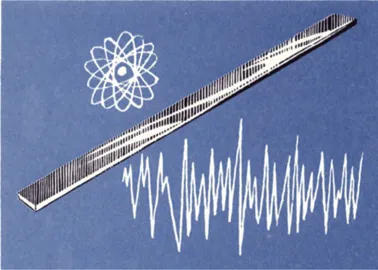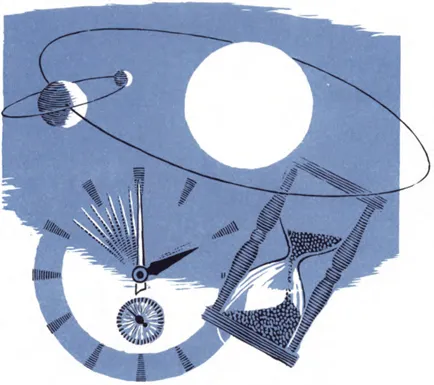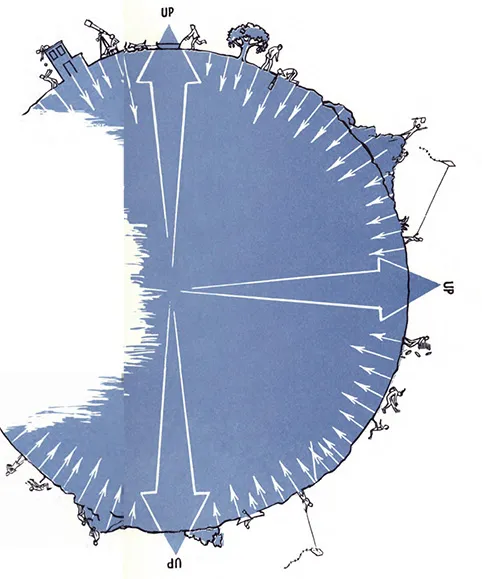1
Absolute or Relative?
Two sailors, Joe and Moe, were cast away on a deserted island. Several years went by. One day Joe found a bottle that had washed ashore. It was one of those new king-size bottles of Coca-Cola. Joe turned pale.
“Hey, Moe!” he shouted. “We’ve shrunk!”
There is a serious lesson to be learned from this joke. The lesson is: There is no way of judging the size of an object except by comparing it with the size of something else. The Lilliputians thought Gulliver a giant. The Brobdingnagians thought Gulliver tiny. Is a billiard ball large or small? Well, it is extremely large relative to an atom, but extremely small relative to the earth.
Jules Henri Poincaré, a famous nineteenth-century French mathematician who anticipated many aspects of relativity theory, once put it in this way (scientists call his way of putting it a “thought experiment”: an experiment that can be imagined but not actually performed). Suppose, he said, that during the night, while you were sound asleep, everything in the universe became a thousand times larger than before. By everything, Poincaré meant everything: electrons, atoms, wavelengths of light, you yourself, your bed, your house, the earth, the sun, the stars. When you awoke, would you be able to tell that anything had changed? Is there any experiment you could perform that would prove you had altered in size?
No, said Poincaré, there is no such experiment. In fact, the universe really would be the same as before. It would be meaningless even to say it had grown larger. “Larger” means larger in relation to something else. In this case there is no “something else.” It would be just as meaningless, of course, to say that the entire universe had shrunk in size.
Size, then, is relative. There is no absolute way to measure an object and say that it is absolutely such-and-such a size. It can be measured only by applying other sizes, such as the length of a yardstick or meter rod. But how long is a meter rod? Originally it was defined as one ten-millionth of the distance from the earth’s equator to one of its poles. This soon gave way to the length of a platinum bar kept in a cellar near Paris. Today it is defined as the distance light travels through a vacuum in one 299,792,458th of a second. How is a second defined? It is 9,192,631,770 vibrations of a cessium atom excited by microwaves. Of course, if everything in the universe were to grow larger or smaller in the same proportion, including the distance light travels in a second, there would still be no experimental way to detect the change.
The same is true of periods of time. Does it take a “long” or “short” time for the earth to make one trip around the sun? To a small child, the time from one Christmas to the next seems like an eternity. To a geologist, accustomed to thinking in terms of millions of years, one year is but a fleeting instant. A period of time, like distance in space, is impossible to measure without comparing it to some other period of time. A year is measured by the earth’s period of revolution around the sun; a day by the time it takes the earth to rotate once on its axis; an hour by the time it takes the long hand of a clock to make one revolution. Always one period of time is measured by comparing it with another.
There is a famous science-fiction story by H. G. Wells called “The New Accelerator.” It teaches the same lesson as the joke about the two sailors, only the lesson is about time instead of space. A scientist discovers a way to speed up all the processes of his body. His heart beats more rapidly, his brain operates faster, and so on. You can guess what happens. The world seems to slow down to a standstill. The scientist walks outside, moving slowly so the friction of the air will not set fire to his pants. The street is filled with human statues. A man is frozen in the act of winking at two passing girls. In the park, a band plays with a low-pitched, wheezy rattle. A bee buzzes through the air with the pace of a snail.
Let us try another thought experiment. Suppose that at a certain instant everything in the cosmos begins to move at a slower speed, or a faster speed,* or perhaps stops entirely for a few million years, then starts up again. Would the change be perceivable? No, there is no experiment by which it could be detected. In fact, to say that such a change had occurred would be meaningless. Time, like distance in space, is relative.
Many other concepts familiar in everyday life are relative. Consider “up” and “down.” In past ages it was hard for people to understand why a man on the opposite side of the earth was not hanging upside down, with all the blood rushing to his head. Children today have the same difficulty when they first learn that the earth is round. If the earth were made of transparent glass and you could look straight through it with a telescope, you would in fact see people standing upside down, their feet sticking to the glass. That is, they would appear upside down relative to you. Of course, you would appear upside down relative to them. On the earth, “up” is the direction that is away from the center of the earth. “Down” is toward the center of the earth. In interstellar space there is no absolute up or down, because there is no planet available to serve as a “frame of reference.”
Imagine a spaceship on its way through the solar system. It is shaped like a giant doughnut and is rotating so that centrifugal force creates an artificial gravity field. Inside the ship, spacemen can walk about the outer rim of the doughnut as if it were a floor. “Down” is now away from the center of the ship, “up” is toward the center: just the opposite of how it is on a rotating planet.
So you see, there are no absolute “ups” and “downs” in the universe. Up and down are directions relative to the direction in which a gravitational field is acting. It would be meaningless to say that while you were asleep the entire cosmos turned upside down, because there is nothing to serve as a frame of reference for deciding which position the cosmos has taken.
Another type of change that is relative is the change of an object to its mirror image. If a capital R is printed in reverse form like this,
, you recognize it immediately as the mirror image of an R. But if the entire universe (including you) suddenly became its mirror image, there would be no way that you could detect such a change. Of course, if only one person became his mirror image (H. G. Wells wrote a story about this also, “The Plattner Story”) while the cosmos remained the same, then it would seem to him as if the cosmos had reversed. He would have to hold a book up to a mirror to read it, the way Alice behind the looking-glass managed to read the reversed printing of “Jabberwocky” by holding the poem up to a mirror. But if
everything reversed, there would be no experiment that could detect the change. It would be just
as meaningless to say that such a reversal had occurred as it would be to say that the universe had turned upside down or doubled in size.
Is motion absolute? Is there any type of experiment that will show positively whether an object is moving or standing still? Is motion another relative concept that can be measured only by comparing one object with another? Or is there something peculiar about motion, something that makes it different from the relative concepts just considered?
Stop and think carefully about this for a while before you go on to the next chapter. It was in answer to just such questions that Einstein developed his famous theory of relativity. This theory is so revolutionary, so contrary to common sense that even today there are thousands of scientists (including physicists) who have as much difficulty understanding its basic concepts as a child has in understanding why the people of China do not fall off the earth.
If you are young, you have a great advantage over these scientists. Your mind has not yet developed those deep furrows along which thoughts so often are forced to travel. But whatever your age, if you are willing to flex your mental muscles, there is no reason why you cannot learn to feel at home in the strange new world of relativity.








